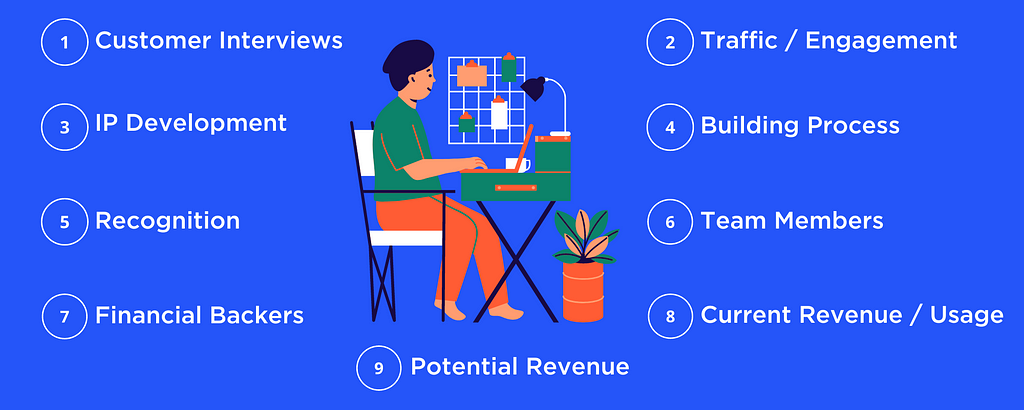Tips for Early-Stage Startups

Are you an early-stage entrepreneur looking to make a splash with your startup? One key aspect that can make a world of difference is demonstrating traction. Traction serves as proof of concept, communicates a path to revenue and profitability, and helps recruit potential employees, collaborators, and advisors.
As you’ll see in this post, there are numerous ways to illustrate that your company is gaining momentum. So if you have yet to earn revenue, don’t worry! The amount of work (hundreds of hours & sleepless nights) is still valuable, and your accomplishments so far can be used to excite partners and get the resources you need to reach your next goal.
Why It’s Important to Show Traction at an Early Stage
Demonstrating traction at an early stage is crucial for startups. It attracts investors, builds credibility, and helps refine the product-market fit. In addition, traction validates the business model, enhances recruitment efforts, and sets the startup apart from competitors in a crowded market.
1. Proof of Concept
Demonstrating traction is essential for validating your idea to the world and yourself. It shows that your concept has potential and can gain traction in the market. This validation is crucial for building confidence and attracting further interest from investors, partners, and customers. It’s also likely to help you sleep a little sounder at night because you’ll have tangible evidence that your business idea resonates with potential customers and has real-world applications.
2. Communicating Revenue Potential
Traction is a powerful way to communicate your startup’s potential revenue, profitability, and economic sustainability to potential investors and lenders. By showcasing early signs of success, such as customer interest, user engagement, or sales, you provide evidence of a viable business model and a clear path to generating revenue. These early signs of traction make your startup more appealing to potential investors and increase the confidence of lenders in receiving repayment.
3. Attracting Talent
As you grow your startup, you’ll need a talented team to support your vision. Demonstrating traction helps attract potential employees, collaborators, and advisors who believe in your product or service. They’ll see the progress you’ve made and the potential for future success, making them more likely to join your journey.

Ways to Define Traction
Revenue is just one of many acceptable forms of traction for early-stage businesses. Look at the different ways traction can be illustrated below and choose the combination that makes the strongest case for your business.
1. Customer Interviews
Engage in customer discovery through formal and informal conversations. Gather feedback from potential customers and industry experts to understand their needs, pain points, willingness to pain, and preferences. Ultimately, these interviews will improve and validate your solution. Showcase the number and quality of these conversations as evidence of market interest.
2. Traffic / Engagement
Measure website visits, clicks, email collection, and social media interactions. These numbers demonstrate the level of attention your startup is generating and can indicate whether people are actively exploring your offerings. Utilize tools like Google Analytics, email marketing platforms, and social media analytics to track and present these figures effectively.
3. Intellectual Property (IP) Development
If your startup involves unique technology, showcase any patents, trademarks, or trade secrets you’ve secured. Intellectual property demonstrates your competitive advantage and signals to investors that you have something valuable, defensible, and exclusive.
4. Building Process
Showcase your product development journey, from initial sketches to the first prototype and customer-tested versions. Use visuals to illustrate progress and evolution. Share before and after usage surveys, highlighting improvements made based on customer feedback. Conduct pilot and beta tests and leverage free tools like Google Forms or SurveyMonkey to gather quantitative data. Shedding light on the development of your product demonstrates that you’re putting in the necessary work and are serious about building the best business possible.

5. Recognition
Highlight media coverage, contests or awards won, and participation in notable accelerators or incubators. This external validation boosts your startup’s credibility and demonstrates industry recognition. List the outlets and programs that have featured your startup to further enhance your reputation. A great first step is to set up a Google Alert for your business.
6. Team Members
Who’s in your corner? Display the team members who support your startup, including advisors, influencers, and investors. Feature their photos, roles, and bios on your website and in your pitch deck. Some startups have even run a social media campaign highlighting their growing team of thought leaders and industry professionals to build trust and increase interest.
7. Financial Backers
If you’ve received grants, achieved crowdfunding success, or secured notable investments, include them when talking about your business in text and verbally. Adding logos of past funders to your website is an easy and effective way to show who believes in your business (always ask for permission!). These acts of support from external sources signify confidence in your startup’s potential.
8. Current Revenue and Usage
If your startup already generates revenue, present the number of sales. You can also highlight agreements signed, pilot users, and the value in dollars or time spent on your platform. Sometimes providing data on the types of users and their usage patterns can also be beneficial. Finally, always collect (& share) customer success stories to emphasize the value you provide. Typically, your first adopters are your biggest cheerleaders, so don’t be afraid to give them a discount or deal in exchange for sharing their testimonials.
9. Potential Revenue
While early sales are essential, potential revenue is equally significant — showcase opportunities for recurring sales or contracts, customer lifetime value, and product expansion plans. Focus on the growth potential of your startup beyond just early sales figures. Present a compelling business model and demonstrate how your startup can scale and attract more customers over time (~3–5 years in the future).
How to Showcase Your Traction
How you share your traction is equally important as the traction you share. Remember the five tips below to have the greatest impact.
1. Audience. Audience. Audience.
Tailor your traction showcasing efforts to your target audience. Investors may be interested in revenue potential, while customers value testimonials and reviews. Adapt your messaging and presentation to resonate with each specific group.
2. Stage-Specific Focus
Depending on the stage your startup is in, emphasize different aspects of traction. If you’re pre-revenue, it’s acceptable to lean on qualitative data, surveys, and interviews. Emphasize the insights you’ve gained and the validation you’ve received from potential customers or users. This qualitative evidence can still be compelling and indicative of traction. Likewise, investors will expect to see revenue if you’ve been around for a few years. So be prepared to share the most important financial indicators of your startup’s health and potential.
3. Be Specific
Use real numbers, real people (names and photos), and concrete details to communicate your traction effectively. Avoid vague statements and provide tangible evidence of your traction. Quantifiable metrics and testimonials from satisfied customers or early adopters add credibility and legitimacy to your claims.
4. Create Content
Leverage various content formats to showcase your startup’s traction. Establish a strong presence on social media platforms, create case studies highlighting your success stories, maintain a press page with media coverage, send regular newsletters, and prepare pitch decks and executive summaries for potential investors. Each piece of content can focus on different aspects of your traction and be tailored to the intended audience. Regularly update these channels to keep your audience informed and engaged.
5. Consistency Matters
Consistency is key when showcasing your startup’s traction. Be active in demonstrating progress and maintain a regular cadence of communication. Keep your social media profiles updated, regularly publish blog posts and articles, and share news about your startup’s progress with important stakeholders (aim for quarterly updates). This consistency instills confidence and reinforces the perception that your startup is making significant strides forward.

Examples of Traction
Need even more examples of traction? Check out the lists below:
Pre-Revenue Traction
- Prototype Photos: Share images of your product’s development stages, from initial sketches to the final prototype, showcasing the progress you’ve made.
- Reviews: Highlight positive feedback and testimonials from users who have tested your product or service.
- Email Subscribers: Showcase the growth of your email list as an indicator of interest and engagement with your startup.
- Crowdfunding Campaign Progress: If you’ve run a successful crowdfunding campaign, present the progress and achievements you’ve made during the campaign, such as funding raised and the number of backers.
- Team Showcase: Introduce your talented team members and their expertise. Include photos and bios to showcase their commitment to your startup’s success.
- Pilot Survey Stats: Present data from pilot tests, including surveys and feedback, to demonstrate market interest and validation.
- Interview Numbers and Product Development Strategy: Highlight the number of interviews conducted with potential customers or industry experts. Discuss how these conversations have shaped your product development strategy.
Post-Revenue Traction
- Sales/Orders: Showcase the number of sales or orders your startup has generated, emphasizing growth over time.
- Ad Performance: Present metrics on the performance of your advertising campaigns, such as click-through rates, conversion rates, and return on investment.
- Media Coverage: Highlight articles, interviews, or features about your startup in relevant media outlets. This serves as social proof and increases your startup’s visibility.
- Customer Reviews: Share positive reviews and testimonials from satisfied customers, showcasing the value and impact of your product or service.
- Case Studies: Develop in-depth case studies demonstrating how your startup has solved specific problems or delivered significant customer results.
Demonstrating traction is crucial for gaining attention, building credibility, and attracting further support for your startup. By showcasing your progress, you create a compelling narrative that captures the interest of investors, customers, collaborators, and advisors. Embrace the various ways to define and showcase traction and proactively communicate your startup’s momentum. With consistent effort and a creative approach, you can maximize your chances of success in the competitive startup landscape.
Remember, the journey may be challenging, but with traction on your side, you’re one step closer to achieving your entrepreneurial dreams.
Special thanks to Talpha Harris of Sustainible and Lindsay Stuart of Mamalux for leading a past workshop on Showing off Your Startup Traction, which served as the foundation for this blog post.
Connect with us
Learn more about Ascender: https://ascenderpgh.com/
Sign up for our newsletter or send us a note: info@ascenderpgh.com
Follow us: Twitter — Facebook — LinkedIn — Instagram
From fledgling tech companies, healthcare innovators, and nonprofits to makers, creators, services and shops, Ascender is for Pittsburgh’s entrepreneurs. We help businesses of all types in the Pittsburgh region start and build a business through education and connectivity. See how Ascender can help you.
The Ultimate Guide to Showing Traction was originally published in Ascender on Medium, where people are continuing the conversation by highlighting and responding to this story.

